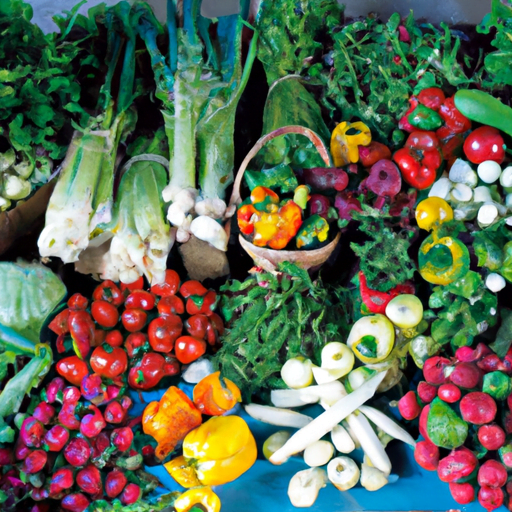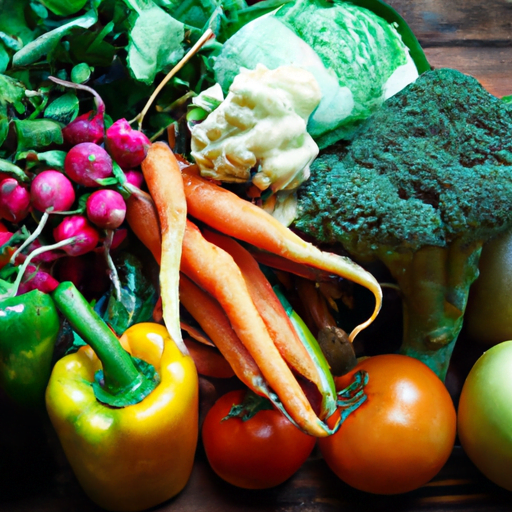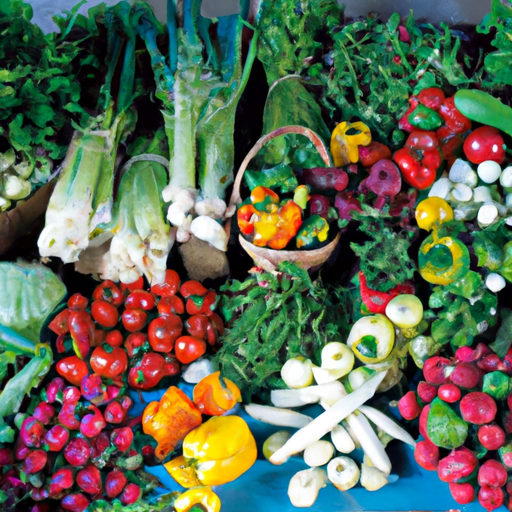So, you’ve decided to live off the grid and start growing your own vegetables. That’s awesome! But what do you do when you have an abundance of vegetables and you want to store them for the long term? Don’t worry, you’re in the right place. In this article, we’ll discuss how to store vegetables for the long term and ensure that you have fresh produce even during the off-season.
Now, the first question that might pop into your mind is – which vegetables can actually be stored for a long time? Well, you’ll be happy to know that there are quite a few options. Root vegetables like carrots, potatoes, onions, and beets have a good shelf life when stored properly. Cabbage, winter squash, and pumpkins are also excellent choices. In fact, you can even store some leafy greens like kale and Swiss chard, if you follow the right techniques. We’ll delve into more specific details in the upcoming paragraphs.
Storing vegetables for the long term is all about creating the right conditions that mimic the natural environment. You’ll need to provide a cool, dry, and dark space for them to thrive. This helps to slow down the ripening process and prevents them from spoiling quickly. The temperature and humidity levels need to be carefully monitored to ensure the vegetables stay fresh and crispy. From using root cellars and coolers to canning, pickling, and freezing techniques, we’ll cover it all in our comprehensive guide.
So, whether you’re a seasoned gardener or just starting out, learning how to store vegetables for the long term is an important skill to have. It not only helps you make the most of your harvest, but also ensures that you have a constant supply of fresh produce throughout the year. So, sit back and relax, because by the end of this article, you’ll be equipped with all the knowledge you need to become a pro at storing vegetables for the long haul.

Introduction
Understanding the importance of long-term vegetable storage
When it comes to ensuring a steady supply of fresh and nutritious vegetables, long-term storage is a valuable skill to have. Whether you live in a remote area, want to reduce your dependency on grocery stores, or simply wish to extend the shelf life of your homegrown produce, knowing how to store vegetables for the long term can be incredibly beneficial.
Benefits of storing vegetables for the long term
Storing vegetables for the long term offers several advantages. Firstly, it allows you to preserve the nutritional value of your vegetables, ensuring that you have access to a wide range of vitamins and minerals throughout the year. Additionally, it helps you save money by avoiding the need to constantly purchase fresh produce. Finally, long-term vegetable storage promotes sustainability and self-sufficiency, as you become less reliant on external sources for your food needs.
Factors to Consider
Temperature and humidity requirements
Temperature and humidity are two crucial factors to consider when storing vegetables for the long term. Most vegetables prefer cool temperatures between 32°F (0°C) and 50°F (10°C) to slow down the ripening process and prevent spoilage. However, it’s important to note that different vegetables have specific temperature requirements. Some, like carrots and potatoes, thrive in cool, dark environments, while others, like tomatoes and cucumbers, prefer slightly warmer temperatures.
Humidity levels are equally important. Most vegetables benefit from high humidity, typically around 90 percent, to maintain moisture and prevent wilting. However, some vegetables, such as onions and garlic, require lower moisture levels to prevent them from becoming soft or moldy. It’s important to find the right balance of temperature and humidity for each vegetable you plan to store.
Choosing the right storage location
Selecting an appropriate storage location is crucial for maintaining the freshness and quality of your long-term stored vegetables. Look for a cool, dry, and well-ventilated area in your home or property. Basements, cellars, or root cellars are often ideal storage locations as they provide a cool and consistent temperature throughout the year.
Avoid storing vegetables near strong odors, as they can easily pick up these smells and affect their flavor. Keep them away from direct sunlight, which can cause vegetables to spoil quickly. Additionally, ensure that the storage area is free from pests and rodents, as they can wreak havoc on your stored produce.
Ideal containers for long-term storage
Choosing the right containers for long-term vegetable storage is essential to maintain their quality. Opt for breathable containers that allow for air circulation, as this helps prevent the buildup of condensation and mold. Crates, baskets, or mesh bags are excellent choices as they provide ample ventilation.
Avoid using plastic bags or airtight containers, as they can trap moisture and lead to spoilage. If you prefer using plastic containers, make sure they have ventilation holes to allow for air exchange. Additionally, label each container with the contents and date of storage to ensure proper rotation.
Preparation and Preservation Techniques
Cleaning and sorting vegetables
Before storing vegetables for the long term, it’s important to clean and sort them properly. Remove any dirt, debris, or damaged parts from the vegetables. This helps prevent the spread of bacteria and fungi that can cause spoilage.
Sort vegetables based on maturity and condition. Use the freshest and healthiest vegetables for long-term storage, while consuming any overripe or damaged ones immediately. Categorize vegetables according to their storage requirements, as different vegetables have specific needs.
Methods of blanching and freezing
Blanching and freezing are common techniques for long-term vegetable preservation. Blanching involves briefly immersing the vegetables in boiling water or steam, followed by rapid cooling in ice water. This process helps retain the color, flavor, and texture of the vegetables, while also destroying enzymes responsible for spoilage.
After blanching, drain the vegetables thoroughly and transfer them to airtight freezer bags or containers. Label each package with the vegetable type and date of freezing. It’s important to note that not all vegetables freeze well, so research the specific requirements of each vegetable before attempting this preservation method.
Canning and pickling for long-term preservation
Canning and pickling are additional methods for long-term preservation. Canning involves heating vegetables in jars or cans to destroy harmful bacteria and seal them for extended storage. Pickling, on the other hand, involves immersing vegetables in a vinegar-based brine to preserve their flavor and texture.
Both canning and pickling require proper sterilization of jars, as well as following specific recipes and instructions. These methods can be time-consuming and require careful attention to ensure safety and quality. It’s important to educate yourself on the proper techniques and guidelines before attempting canning or pickling.

Root Vegetables
Proper storage conditions for root vegetables
Root vegetables, such as carrots, potatoes, and beets, are excellent candidates for long-term storage. They prefer cool and dark conditions, with temperatures between 32°F (0°C) and 40°F (4°C). Store root vegetables in a dry environment to prevent rotting or sprouting.
Popular root vegetables for long-term storage
Carrots are known for their extended shelf life when stored properly. Remove the green tops and store them in a breathable bag or container with moist sand or sawdust. Potatoes can be stored in a cool and dark place, preferably in a wooden crate or a burlap sack to allow for air circulation. Beets can be stored in a similar manner, with their greens removed.
Tips for extending the shelf life of root vegetables
To extend the shelf life of root vegetables, periodically check for spoilage and remove any rotting or damaged pieces. Avoid washing root vegetables before storage, as excess moisture can lead to mold or decay. Additionally, storing vegetables in layers of straw or newspaper can help maintain humidity levels and prevent them from drying out.
Leafy Greens
Preserving leafy greens for extended periods
Leafy greens, like spinach, kale, and lettuce, can be stored for an extended period with the right techniques. These delicate vegetables require careful handling and storage conditions to maintain their freshness and texture.
Best practices for storing leafy greens
To store leafy greens for the long term, start by removing any damaged or yellowed leaves. Rinse them thoroughly and dry them completely, as excess moisture can cause wilting or rotting. Wrap the greens loosely in paper towels or place them in breathable bags to absorb any excess moisture. Store in the refrigerator crisper drawer or a cool, dark place.
Leafy green varieties suitable for long-term storage
Some leafy green varieties are better suited for long-term storage due to their hardiness and ability to retain freshness. Swiss chard, collard greens, and cabbage are examples of leafy greens that can be stored for several weeks when properly prepared and stored. These greens are versatile and can be used in a variety of dishes throughout the storage period.
Cruciferous Vegetables
Long-term storage options for cruciferous vegetables
Cruciferous vegetables, such as broccoli, cauliflower, and Brussels sprouts, can be stored for an extended period with the right conditions. These vegetables require cool and moist storage environments to maintain their freshness.
Maintaining freshness and quality of cruciferous vegetables
To maintain the freshness and quality of cruciferous vegetables, wrap them in damp paper towels or store them in perforated plastic bags to maintain humidity. Place them in the crisper drawer of the refrigerator or a cool basement. Check for any signs of decay or spoilage regularly and remove any affected pieces promptly to prevent the spread of rot.
Recommended cruciferous vegetables for storing
Broccoli and cauliflower are excellent cruciferous vegetables for long-term storage. Trim the leaves and remove any damaged florets before storing. Brussels sprouts can also be stored for an extended period. Remove any loose or discolored leaves, and store them in a breathable bag or container.
Nightshade Family Vegetables
Storing nightshade family vegetables for the long term
Nightshade family vegetables, such as tomatoes, peppers, and eggplants, can be stored for an extended period if handled and stored properly. These vegetables require specific conditions to maintain their flavor and texture.
Tips for preventing the spoilage of nightshade vegetables
To prevent spoilage of nightshade family vegetables, store them at room temperature if they are fully ripe. However, if they are still on the unripe side, store them in a cool and dark place to allow them to ripen slowly. Avoid storing them in the refrigerator, as this can cause the loss of flavor and texture.
Nightshade vegetables with extended shelf life
Certain nightshade family vegetables have a longer shelf life compared to others. For example, green tomatoes can be stored for several weeks in a cool and dark place, allowing them to ripen gradually. Peppers, both sweet and hot varieties, can also be stored at room temperature for a few weeks when properly handled.
Other Vegetables
Unique storage requirements for specific vegetables
Apart from the aforementioned vegetable categories, some vegetables have unique storage requirements due to their nature or characteristics. For example, onions and garlic prefer dry and well-ventilated conditions to prevent moisture buildup and mold growth. Store them in a cool and dry place, preferably in mesh bags or baskets.
Preservation methods for less common vegetables
Less common vegetables, such as artichokes, asparagus, and fennel, can also be stored for the long term with the right techniques. Artichokes require their tough outer leaves trimmed and stored in a cool and humid environment. Asparagus can be stored by trimming the ends and standing them upright in a container with water. Fennel can be wrapped in damp paper towels and stored in the refrigerator.
Exploring alternative techniques for long-term vegetable storage
While the techniques mentioned above are commonly used for long-term vegetable storage, it’s worth exploring alternative methods that suit your specific needs. Dehydrating vegetables, vacuum sealing, or using root cellars are additional options to consider. Research and experiment with different techniques to find the ones that work best for you.
Rotation and Monitoring
Importance of rotation to avoid spoilage
Rotating your stored vegetables is crucial to avoid spoilage and ensure that you consume the oldest produce first. Regularly check for any signs of spoilage, such as mold, wilted leaves, or soft spots. Remove any spoiled vegetables promptly to prevent the spread of decay.
Regular monitoring and inspection of stored vegetables
Regularly monitor and inspect your stored vegetables to ensure their quality and shelf life. Check for changes in color, texture, or smell, as these can be signs of spoilage. Adjust temperature, humidity, or storage conditions as needed based on the specific requirements of each vegetable.
Troubleshooting common issues during long-term storage
During long-term storage, issues such as mold growth, pests, or improper storage conditions may occur. If you encounter mold on your vegetables, remove the affected pieces and adjust the storage conditions to reduce humidity. If pests are present, try using natural deterrents such as bay leaves or lavender sachets. It’s important to address these issues promptly to prevent further damage and ensure the longevity of your stored vegetables.
Conclusion
Summing up the benefits of long-term vegetable storage
In conclusion, learning how to store vegetables for the long term offers numerous benefits. It allows you to preserve the nutritional value of your produce, save money, and promote sustainability. By implementing proper temperature and humidity controls, choosing the right storage location and containers, and utilizing various preservation techniques, you can successfully store a wide range of vegetables for extended periods.
Tips for successfully storing vegetables for extended periods
To store vegetables for the long term, clean and sort them properly, and choose the appropriate preservation techniques based on their specific requirements. Ensure the right temperature, humidity, and storage conditions for each vegetable, and regularly rotate and monitor your stored produce to prevent spoilage.
Encouraging sustainability and self-sufficiency through vegetable storage
Storing vegetables for the long term is not only a practical skill but also a way to promote sustainability and self-sufficiency. By reducing reliance on external sources for fresh produce, you can take control of your food supply and reduce the environmental impact of transportation and packaging.
Living off-grid or simply embracing a more sustainable lifestyle becomes easier when you have the knowledge and ability to store vegetables for the long term. So start incorporating these techniques into your routine, and enjoy the benefits of fresh, nutritious vegetables all year round.




